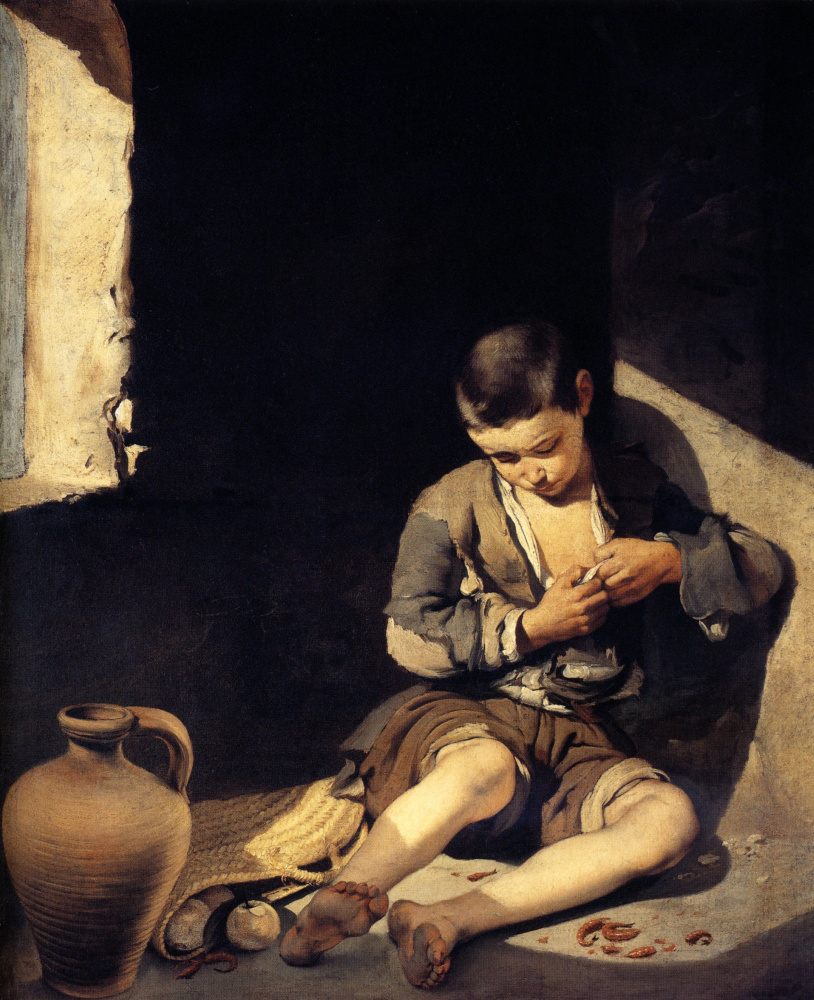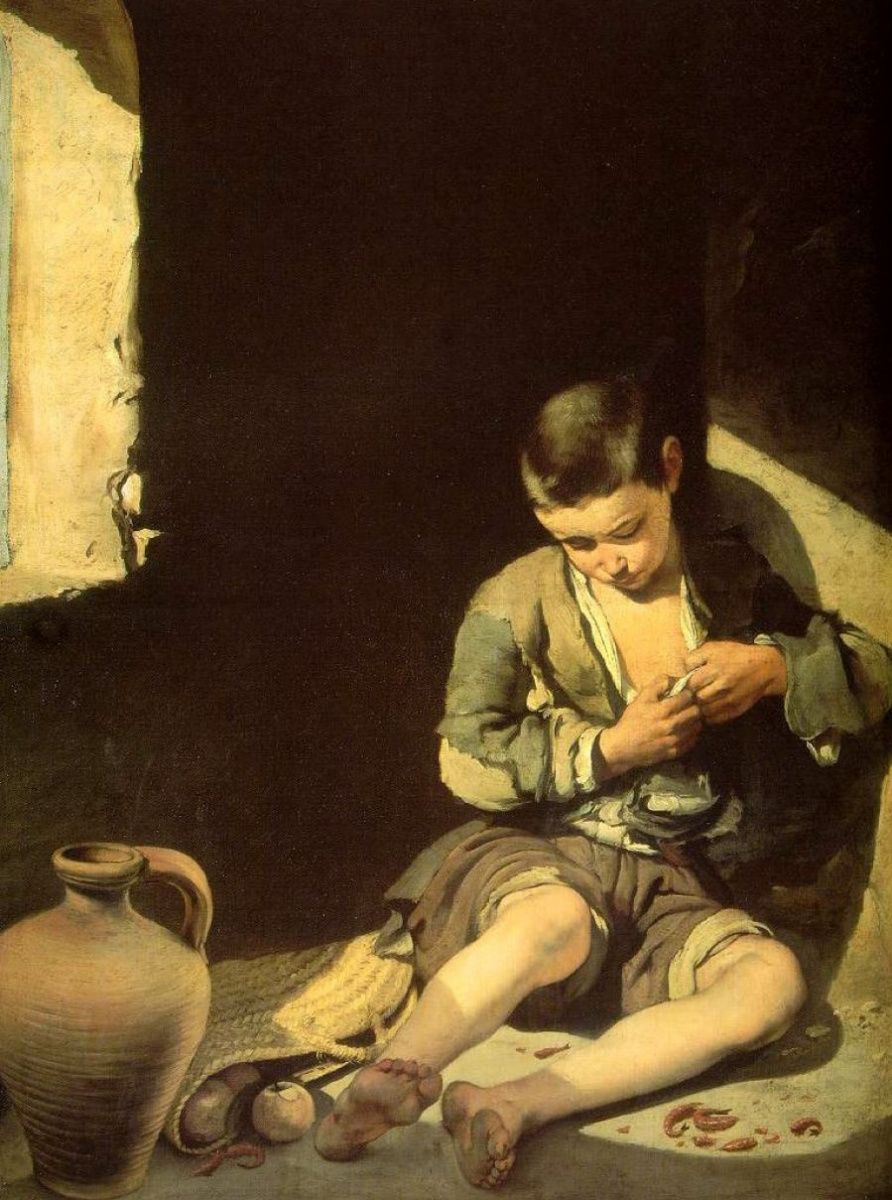log in
Enter site
Login to use Arthive functionality to the maximum
The little beggar (Lousy)
Bartolomé Esteban Murillo • Peinture, 1650, 134×110 cm
Descriptif de la toile «The little beggar (Lousy)»
Early painting Bartolome Esteban Murillo is known under two names – "Lousy" and "The little beggar".
Seville where I went the whole life of the artist, was truly a city of contrasts, amazed by the luxury and misery at the same time. Major port sharing with neighbouring Cadiz exclusive right to redistribute the gold from the American colonies, Seville fabulously enriched a few, but left behind life much more. Frequent crop failures and unsustainable economy led to the appearance on the streets of a colossal number of beggars. Weak and miserable, beggars and vagrants, as well as different crooks with peculiar subculture that has defined the look of the Seville of the mid XVII century. One of the most common and affordable types of earnings for this category of people was posing to artists.
Murillo often wrote of the city's children the "bottom" with their simple pleasures ("Consumers of melon and grapes", "Children playing dice", "Fruit basket"). But children in painting Spain was not opening. And to Murillo, the Spanish XVII century wrote many children and willingly. However, due to circumstances that children's portraits by Murillo during his lifetime began to use the tremendous demand in Europe. It is known that English, German and French sailors and merchants, approaching to Spanish shores, hunted just for "poor kids" Murillo. Many of them were in European museums. "The little beggar", for example, successfully settled in the Louvre.
The huge popularity of "Lousy" in the nineteenth century is due, in addition to the purely artistic aspects, two factors. First, the need of the society in socio-humanistic art. Secondly the fact that the artists democratic direction seen in Murillo some sort of school of excellence. According to the Louvre's archives, in just one 1853, the year of copying of the "Little beggar" signed up 68 people.
On the mud floor of a dark closet with low cut-through window, leaning back against the wall, sits a boy. In the inclined slide face of the shadow, making his expression seem whiny and sleepy. Barefoot and dirty feet of rags scattered on the floor littered, and the old basket of apples which have fallen give you the feeling of extreme homelessness. The boy tries to catch the insect in the folds of clothing, and at his feet lie red shells recently eaten shrimp.
Like others of his contemporaries-the Spaniards, Murillo experienced its period of "tenebrism" - Hobbies sharp contrasts of light and shadow in the spirit Caravaggio. This is clearly seen in "the Little beggar", which uses the technique of whipping out from the darkness and is operated purely caravaggesque naturalism. Nasty yellow light does not give the boy privacy, relentlessly pushes towards the viewer the nudity of his legs and filthy rags. All this allows Murillo to make a small, but poignant story about the orphanage.
Author: Anna Yesterday
Seville where I went the whole life of the artist, was truly a city of contrasts, amazed by the luxury and misery at the same time. Major port sharing with neighbouring Cadiz exclusive right to redistribute the gold from the American colonies, Seville fabulously enriched a few, but left behind life much more. Frequent crop failures and unsustainable economy led to the appearance on the streets of a colossal number of beggars. Weak and miserable, beggars and vagrants, as well as different crooks with peculiar subculture that has defined the look of the Seville of the mid XVII century. One of the most common and affordable types of earnings for this category of people was posing to artists.
Murillo often wrote of the city's children the "bottom" with their simple pleasures ("Consumers of melon and grapes", "Children playing dice", "Fruit basket"). But children in painting Spain was not opening. And to Murillo, the Spanish XVII century wrote many children and willingly. However, due to circumstances that children's portraits by Murillo during his lifetime began to use the tremendous demand in Europe. It is known that English, German and French sailors and merchants, approaching to Spanish shores, hunted just for "poor kids" Murillo. Many of them were in European museums. "The little beggar", for example, successfully settled in the Louvre.
The huge popularity of "Lousy" in the nineteenth century is due, in addition to the purely artistic aspects, two factors. First, the need of the society in socio-humanistic art. Secondly the fact that the artists democratic direction seen in Murillo some sort of school of excellence. According to the Louvre's archives, in just one 1853, the year of copying of the "Little beggar" signed up 68 people.
On the mud floor of a dark closet with low cut-through window, leaning back against the wall, sits a boy. In the inclined slide face of the shadow, making his expression seem whiny and sleepy. Barefoot and dirty feet of rags scattered on the floor littered, and the old basket of apples which have fallen give you the feeling of extreme homelessness. The boy tries to catch the insect in the folds of clothing, and at his feet lie red shells recently eaten shrimp.
Like others of his contemporaries-the Spaniards, Murillo experienced its period of "tenebrism" - Hobbies sharp contrasts of light and shadow in the spirit Caravaggio. This is clearly seen in "the Little beggar", which uses the technique of whipping out from the darkness and is operated purely caravaggesque naturalism. Nasty yellow light does not give the boy privacy, relentlessly pushes towards the viewer the nudity of his legs and filthy rags. All this allows Murillo to make a small, but poignant story about the orphanage.
Author: Anna Yesterday



